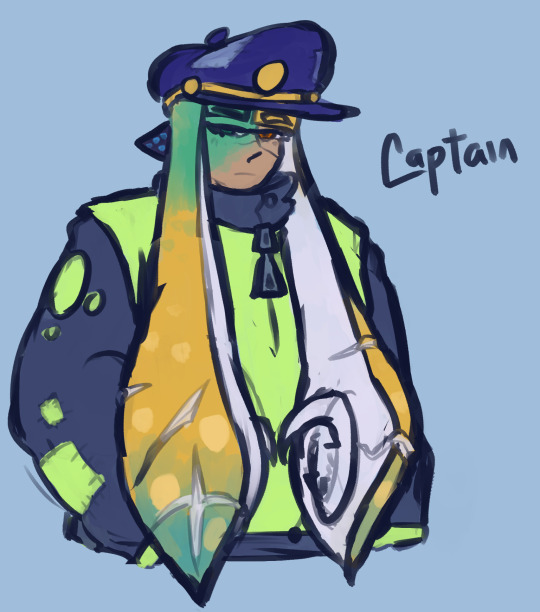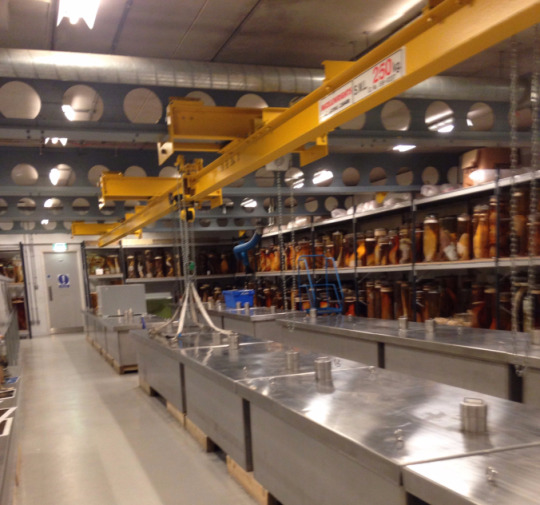#did you know colossal squids have hooks on their suckers
Text

In other news, that Captain 3, huh
#Splatoon#Splatoon 3#captain splatoon#agent 3#splatoon agent 3#splatoon agent#my art#I really like Captain a lot#I think they’d be a colossal squid#that’s why there’s hooks on their suckers!#did you know colossal squids have hooks on their suckers#and giant squids have teeth on theirs!#I love the ocean#it terrifies me to this day
182 notes
·
View notes
Text
In China Mieville’s Kraken, a Giant Squid has been stolen by unimaginable means from the Natural History Museum’s collection of pickled, jarred, and gross things (aka the Spirit Collection). The search for the disappeared cephalopod leads an unprepared museum curator, Billy Harrow, into the demimonde of demigods, cults, magic and spirits. It’s an entertaining jaunt, but since I first read it, I have been desperate to see the secret underbelly of the Natural History Museum for myself.
The book opens with the museum’s actual Spirit Collection tour from Billy’s perspective, but since the book came out in 2008 and I finally visited in 2017, the experiences were a bit different. Instead of meeting in the grand Victorian cathedral to Science, the tour now begins in a hall lined with highlights of the collection just inside the new-since-2009 Darwin Centre, a large Cocoon where you can see scientists at work. Glass walls let you peer into labs and get a sneak peek into what appeared to be the lizard portion of the collection. I recognized myself in the eager know-it-all geeks in Billy’s “standard” cast of museum tour group characters, but I was attached to a group of Google employees enjoying a team building exercise.
I felt more like I was slipping into the story when I saw the same video feed of a large fish being cleaned by flesh eating beetles. I also got to flaunt my knowledge of collections management by correctly describing the ideal environment (18-19 degrees celsius and a relative humidity under 40%) which sounds clinical and boring compared to the eerie experience of descending into a dark, cool basement guarded by double security doors with flickering automatic lights.
I expected long rows of creepy specimens, rather like the pathology collection where I once spent an uncomfortable hour researching Victorian surgical specimens. Kraken promised:
The visitors […] were in a specimen maze. Ranked intricacies. Kilometres of shelves and jars. In each was a motionless floating animal.
Sadly, nowadays practical conservation concerns trump romantic aesthetics. On my tour, the majority of the collection was hidden away in metal lockers, and only a few were open to show some gruesome highlights. It wasn’t until we reached the tank room – containing all of the over-sized specimens – that the mad scientist aesthetic won through.
It wasn’t until we reached the tank room that the mad scientist aesthetic won through. Here be monsters, indeed. The cold steel shelves around the room were lined with large fish in jars, “grotesque mouthfuls like pickled onions,” a shark jaw in a box, snakes floating around each other like Medusa’s hair in the bath, and the piece de resistance – the long, long squid down the center.
It was a Linnaean décor; species clined into each other. There were steel bins, pulleys that hung like vines. […] This was what they came for, that pinkly enormous thing. For all its immobility; the wounds of its slow-motion decay, the scabbing that clouded its solution; despite its eyes being shrivelled and lost; its sick colour; despite the twist in its skein of limbs, as if it were being wrung out. For all that, it was what they were there for.
It would hang, an absurdly massive tentacled sepia event. Architeuthis dux. The giant squid.
Archie the squid is 8.62 meters long (about 28 feet for Americans), although this species can grow up to 15 meters. Seeing the size of the tank itself, I could see why it’s disappearance would be such an impossibility. The monstrous beak was kept in a separate jar so the guide could take it out and demonstrate the avian way it moves. It looked incongruous for something so squishy, exactly like the beak of a parrot. Floating above Archie’s tentacles is a piece of a colossal squid’s arm. While the giant has the calamari-esque suckers you’d expect, the colossal has vicious hooks. Long before this beastie was ever found, scars from their tentacles have been found on sperm whales.
The squid might have been the initial draw to the tank room, but the other specimens were just as if not more fascinating. I saw a celocamph – a fish we thought was extinct until it was found recently off the coast of South Africa. It’s fins have the same bones found in our hands and feet. The echidna mentioned in Kraken is part of a collection of Australian marsupials (including platypuses) that Richard Owen dissected himself in an attempt to prove them hoaxes. They challenged his view of science and possibly supported evolution – so of course he had to discredit them.
The last case pointed out in the tour was not flashy like Archie or gruesome like the jars filled with the same species packed on top of each other – just a few shelves with smaller, singular specimens. All but one have had updated labels with garish yellow stickers, but the tour guide (like Billy the curator) pointed out a flat fish with an aging brown label. These specimens are a portion of Darwin’s collection from his journey with the Beagle, the journey where he formed his thoughts on evolution and changed science forever. The yellow markers show them as “type specimens,” and as soon as this is pointed out I noticed that most of the other jars around the room have yellow labels, too, and I found this even more impressive than the giant squid.
Type specimens – the “bottled Platonic essences that define everything like them” as Mieville described – are literally the first samples of that species to be studied and preserved. They are the specimen by which others are compared and measured. The only species without a type specimen is Homo sapiens (although for a laugh some scientists did decide that Carl Linnaeus must be the type since he only used himself as a study when describing our species).

My experience touring the spirit collection was remarkably similar in feel to when I viewed reliquaries in Munich or Paris. The darkness, the hush, preserved saints in glass coffins, finger bones in elaborate cages, bejeweled skulls. Yes it lacked the clinical steel and class, but the feel was the same. The niggling horror that something died and it’s (his/her) body was manipulated for a purpose that served only the living.
For 10 quid, you can see all the ooey gooey pickled animals you want, and it’s a behind the scenes tour well worth it that lets the museum show off the current work they’re doing. Transparency is a recent theme in museum collections. The Natural History Museum has the Darwin Centre with it’s glass walled labs, but other museum focus on opening up their collections stores. Hundreds, thousands, millions of objects that are in storage in perpetuum, that wouldn’t be seen if not for the tours or open storage displays their museums instigate.
The Spirit Collections is one great example of how the public can use museum collections. Mieville was inspired to write Kraken, Speedo used their shark skin collections to inspire swimsuits for Olympians, and Damien Hirst’s’ animals in tanks were prepared by the same people who made the squid’s tank. Museum collections and store rooms are stagnant, but are being used for research and inspiration behind the scenes. Not just a place to visit, they are an active resource.
It’s worth checking to see if your favorite museum has any form of open storage or tours of their collection, because it’s a chance to see objects not usually on display and to see the work the museum is doing behind the scenes. And maybe, a trip into the museum’s underbelly will inspire you, too.
Explore Further
Kraken by China Mieville
China Mieville’s Website
Stuffed Animals and Pickled Heads: The Culture and Evolution of Natural History Museums by Stephen T. Asma
The Spirit Collection: Behind the Scenes at the Natural History Museum
The Darwin Centre Spirit Collection
Archie the Giant Squid
The Ethics of Open Storage in Museum Collections
Read about the collection and #giantsquid 🦑 @NHM_London that inspired #Kraken #ChinaMieville In China Mieville's Kraken, a Giant Squid has been stolen by unimaginable means from the Natural History Museum’s collection of pickled, jarred, and gross things (aka the Spirit Collection).
#China Mieville#Collecting#Collection Tours#colossal squid#Darwin#Ethics#giant squid#London#natural history#Open Storage#Science#Specimens#Spirit Collection#squid#Transparency
4 notes
·
View notes